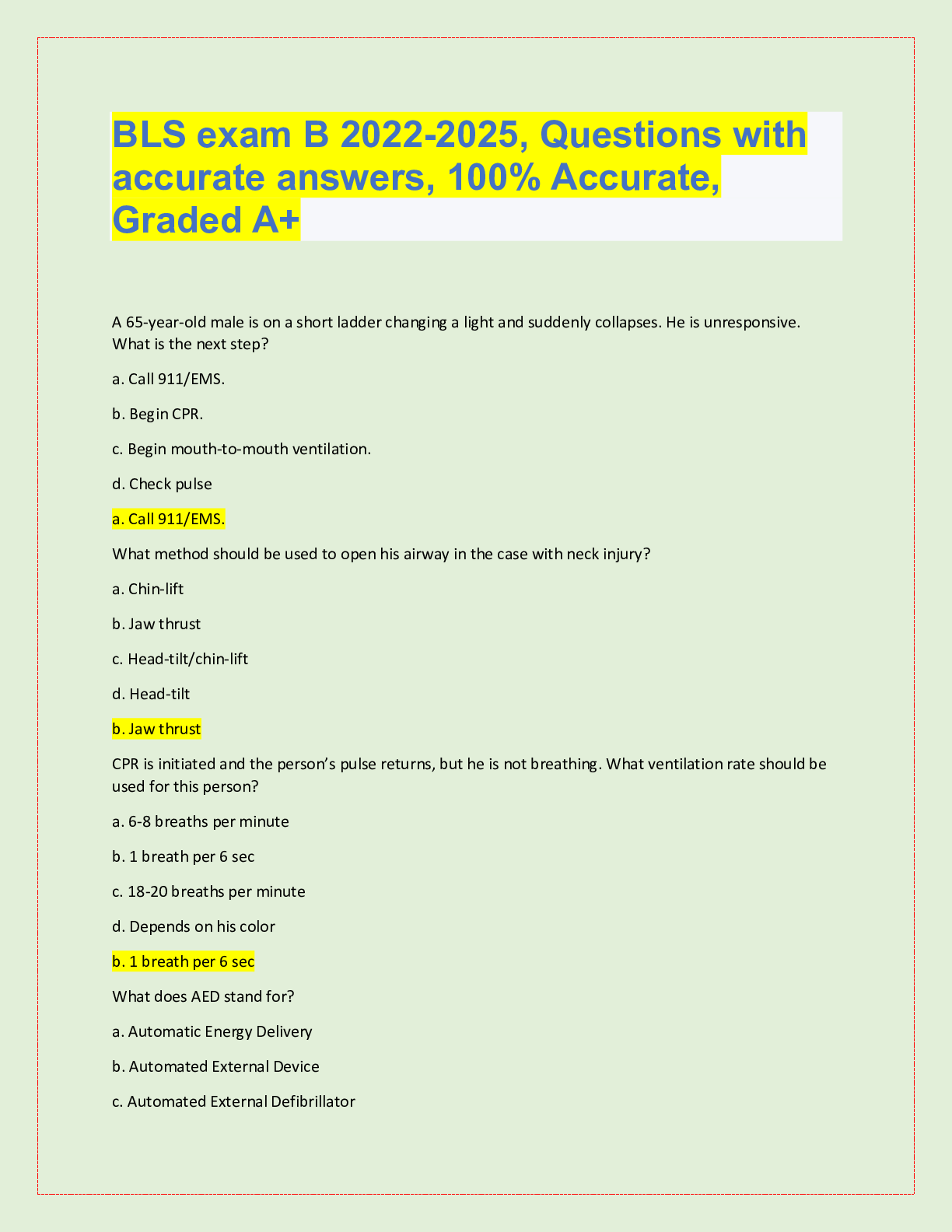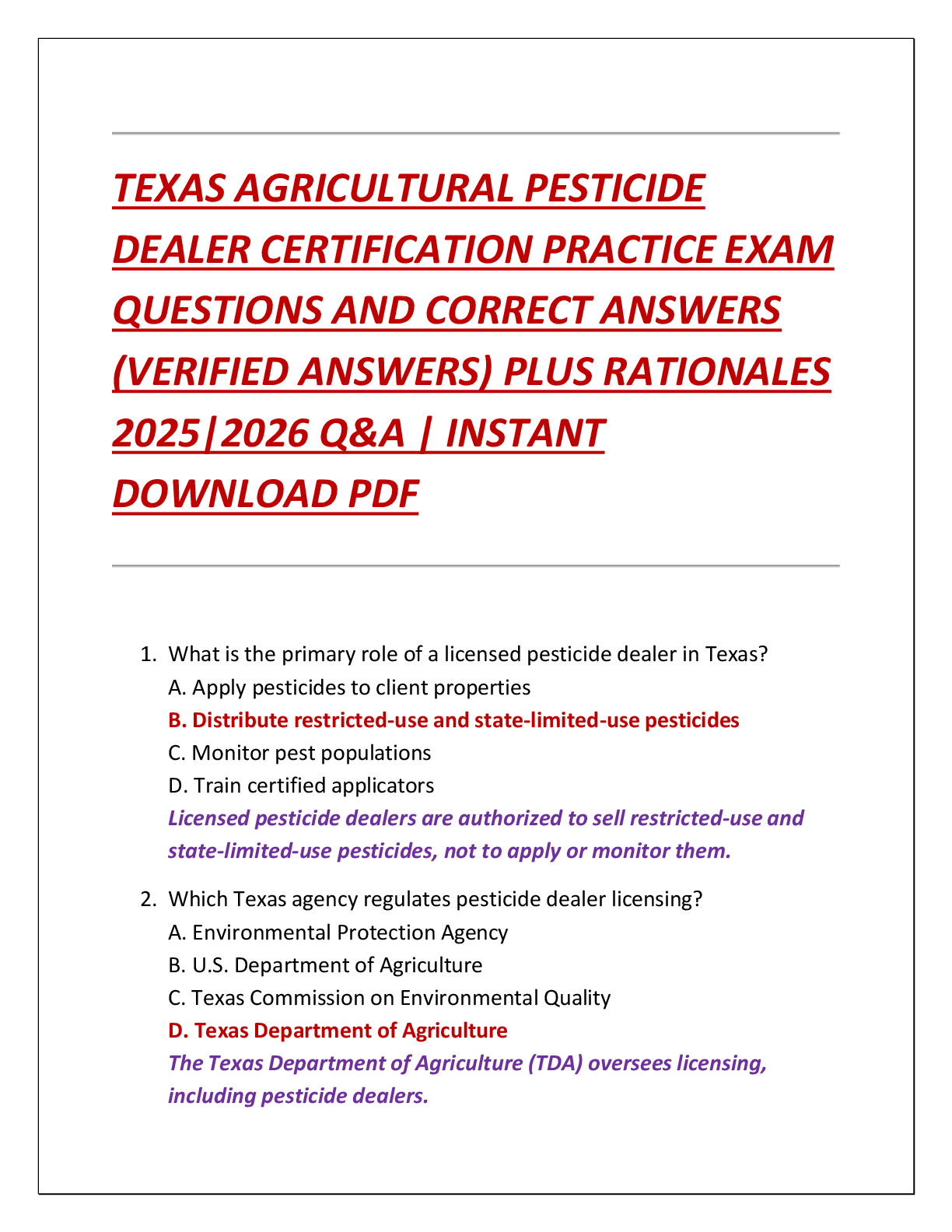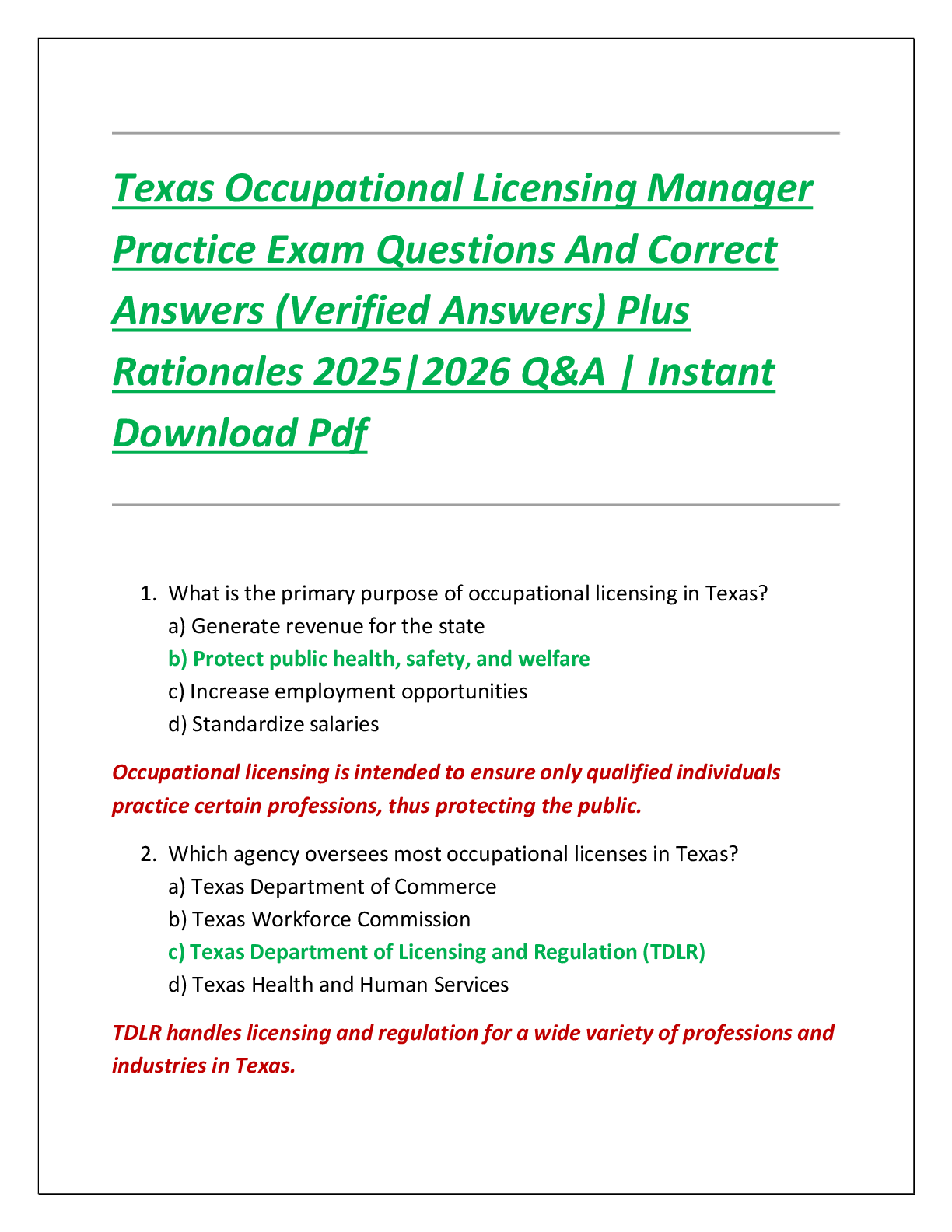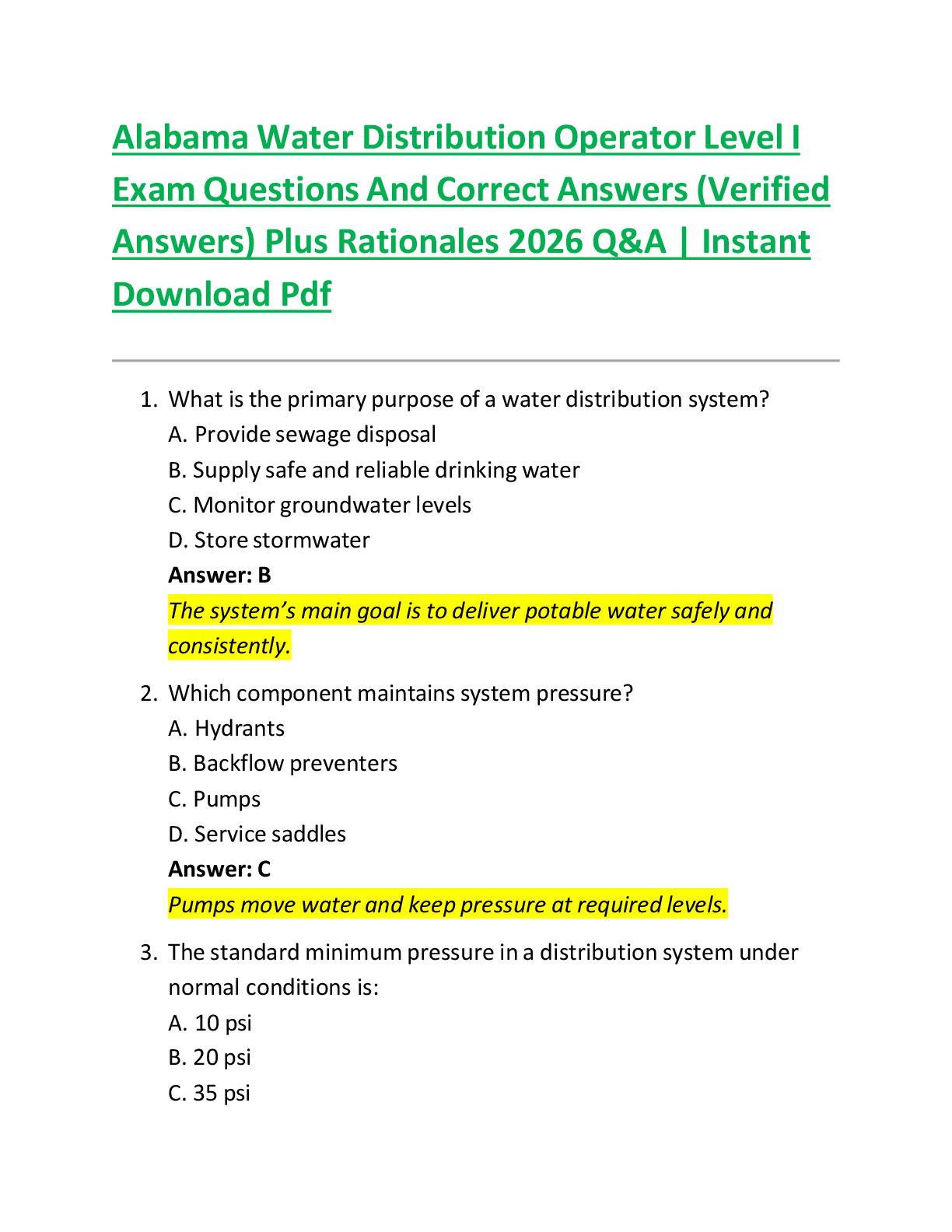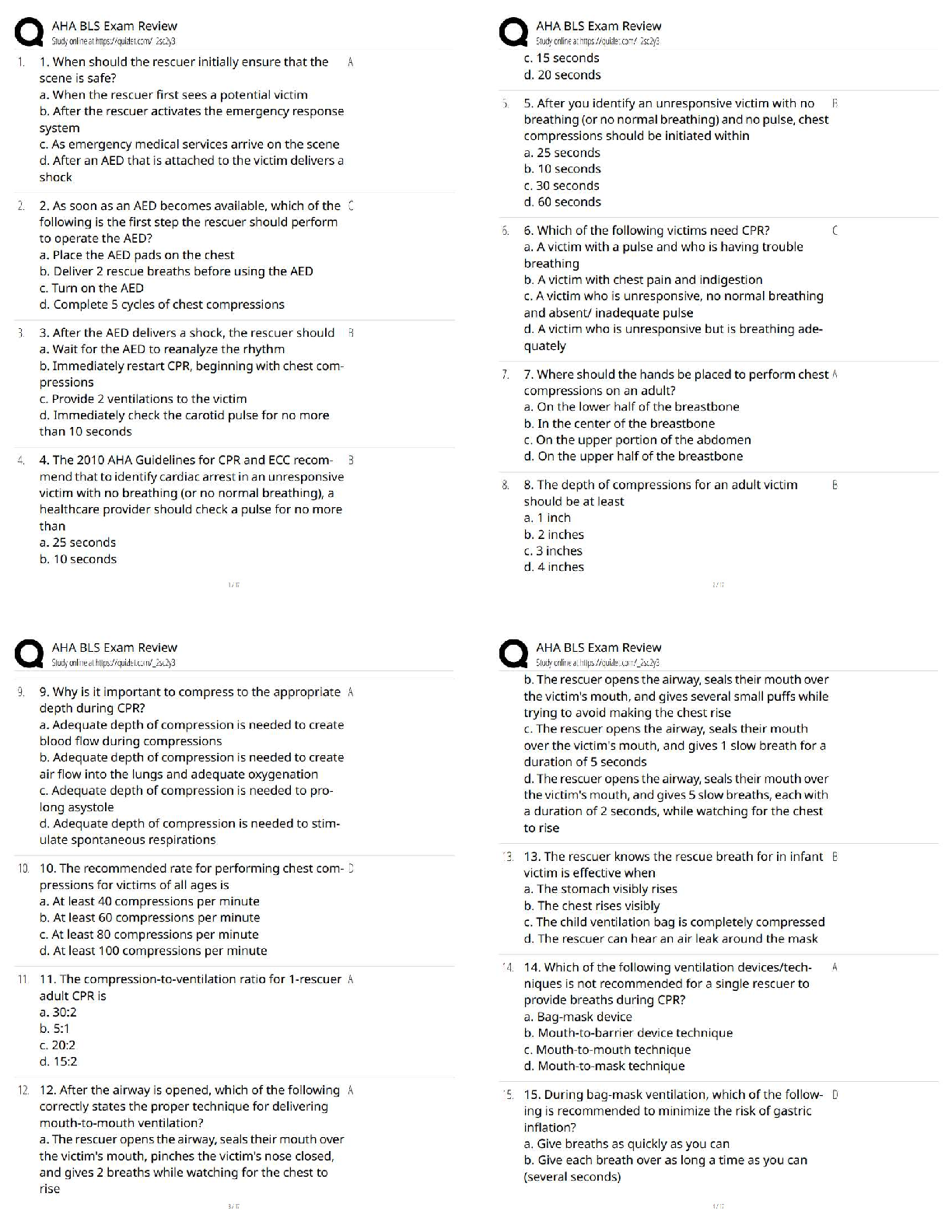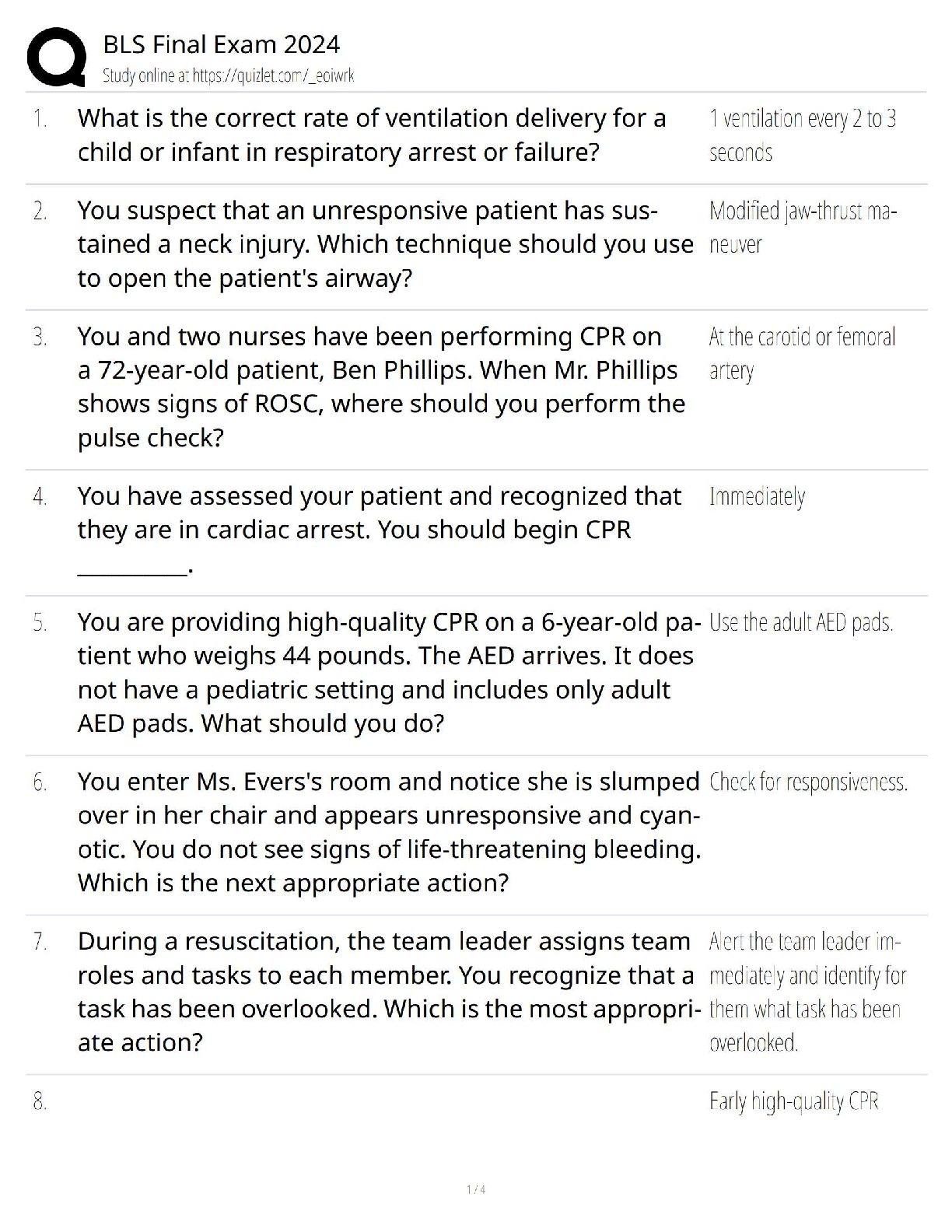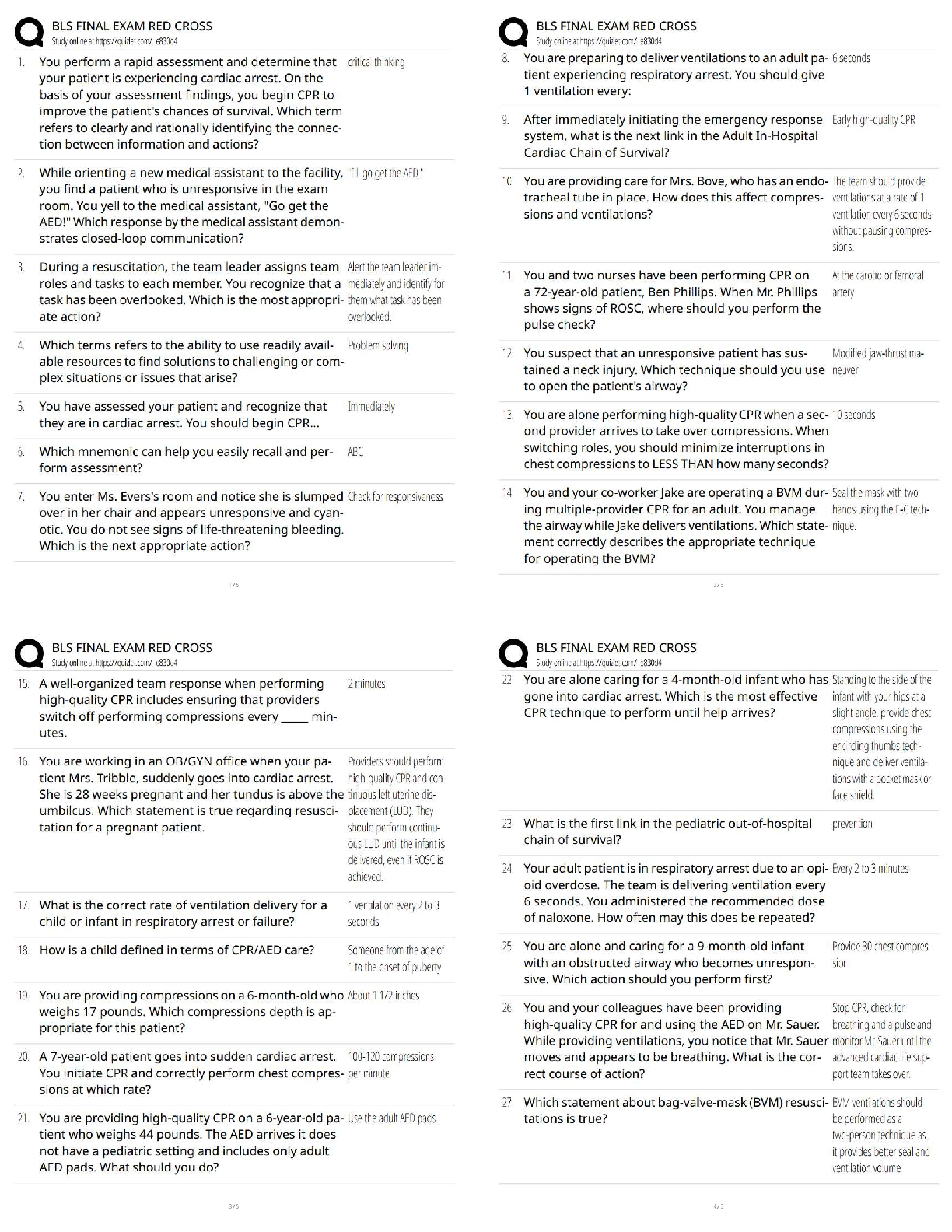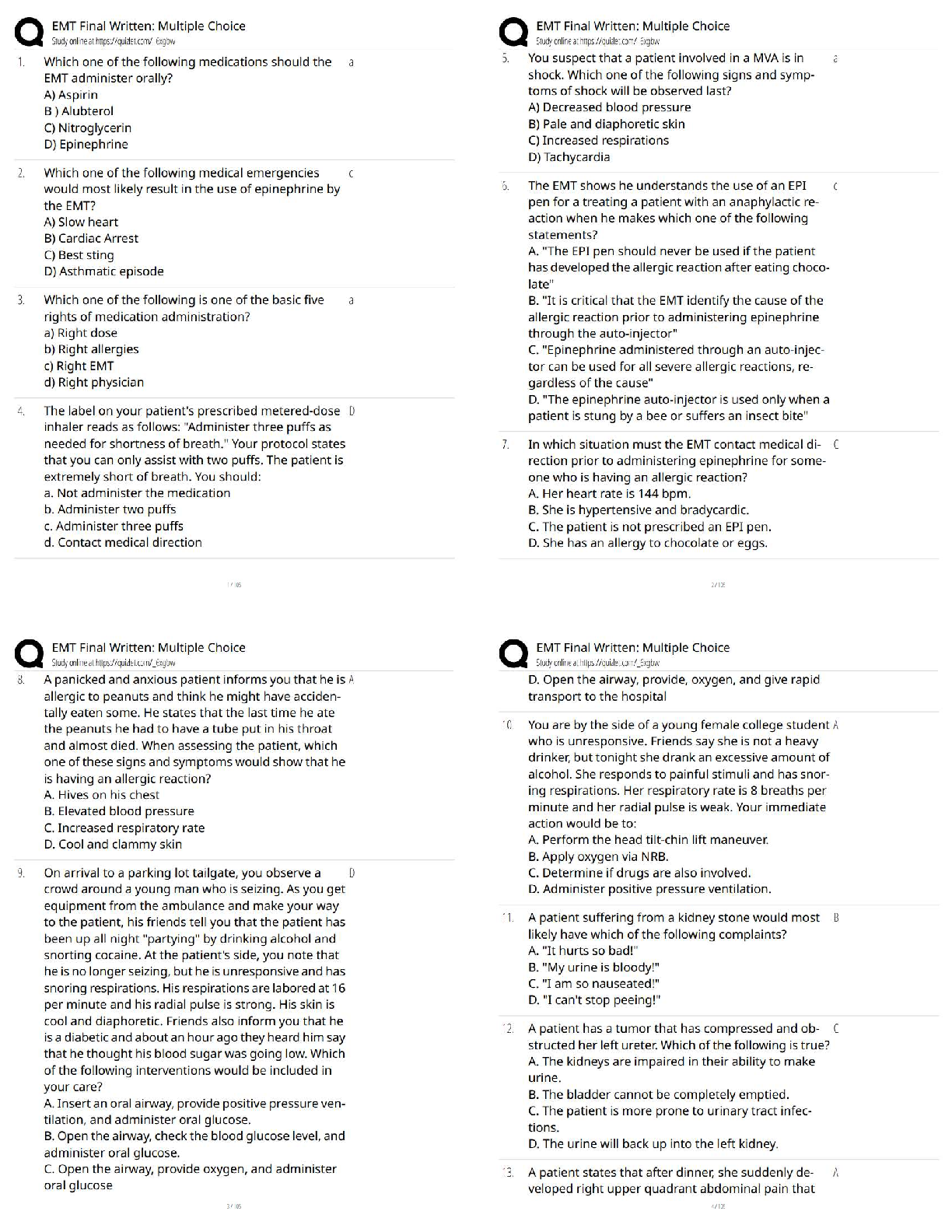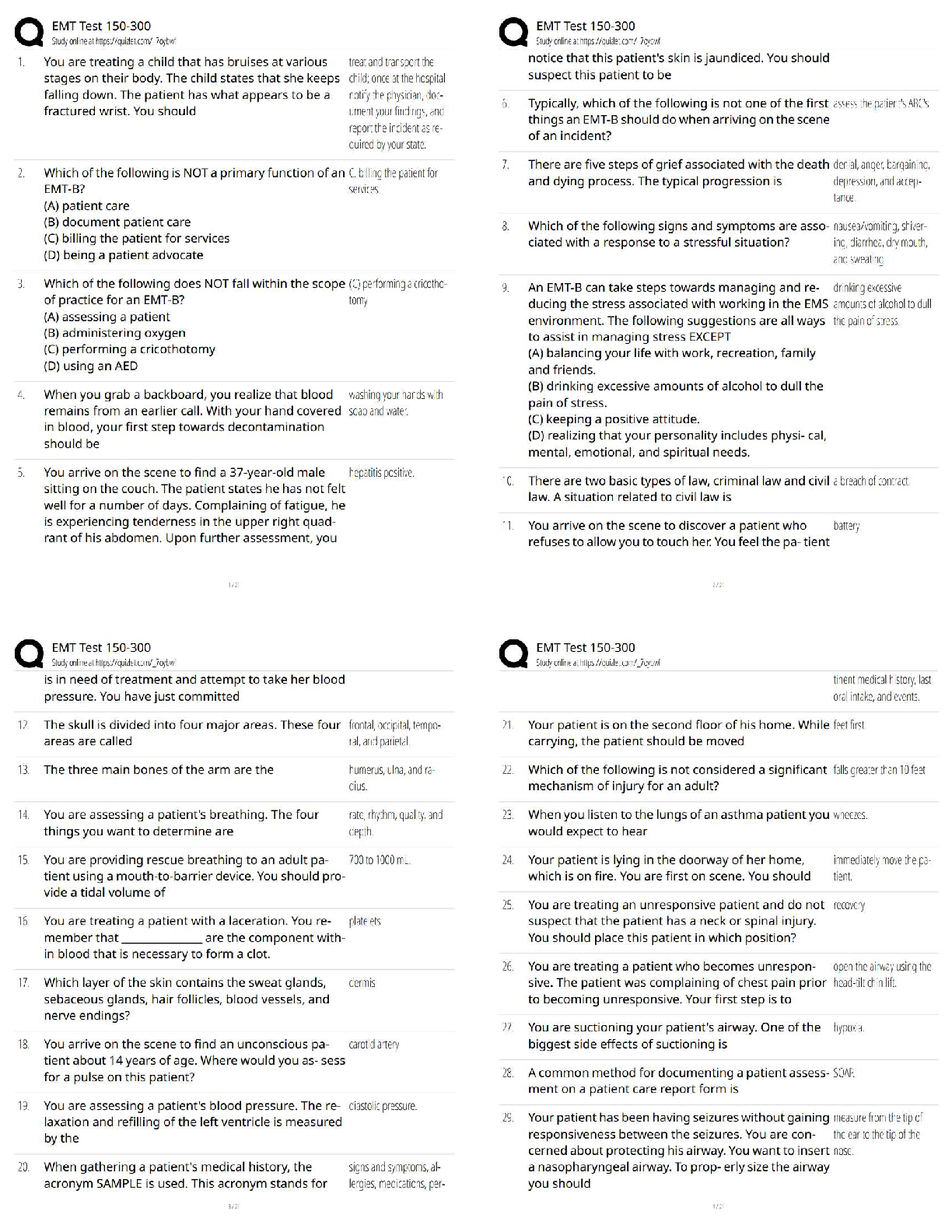Biology > QUESTIONS & ANSWERS > Module 2 - IKE & TICA, Questions and answers. 100% accurate, graded A (All)
Module 2 - IKE & TICA, Questions and answers. 100% accurate, graded A
Document Content and Description Below
Module 2 - IKE & TICA, Questions and answers. 100% accurate, graded A Rank the following from least to most inclusive: -ecosystem -behavior -community -population - ✔✔behavior < populat ... ion < community < ecosystem On Earth, there are Hadley Cells and total atmospheric circulation cells. a. 1;2 b. 2;2 c. 1;3 d. 2;6 e. 1 or 2; a variable number - ✔✔d. 2;6 Theoretically, which would be the most effective way to disrupt a Hadley cell? a. Increase moisture at the poles. b. Remove all moisture and convection from the equator. c. Remove the tilt in the earth's axis so the Sun always shines directly on the equator. d. Extensively water the deserts. e. B and C. - ✔✔b. Remove all moisture and convection from the equator. How are terrestrial biomes arranged? a. By latitude only b. By elevation only c. By longitude only d. By latitude and elevation e. None of these - ✔✔d. By latitude and elevation A seed gets trapped in the ice on the surface of a pond in winter. As the pond thaws in early spring, the seed a. Remains in the surface waters b. Sinks down a few feet and then stays in stratified layer A on the diagram c. moves with the water currents, initially down to the lake bottom. d. Any of these is possible. - ✔✔c. moves with the water currents, initially down to the lake bottom. Based on your scrutiny of 6 terrestrial biomes, you conclude that biomes are distinguished by a. Latitude and longitude b. Elevation c. Temperature and precipitation d. Country of origin e. A and B. - ✔✔c. Temperature and precipitation If savannah experiences 100s of years of drought, the biome will likely convert to a. subtropical desert b. tropical wet forest (rainforest) c. temperate grassland d. arctic tundra e. boreal forest f. temperate forest - ✔✔a. subtropical desert Theoretically, which would be the most effective way to disrupt (stop the direction and magnitude of movement) a Hadley cell? a. Increase moisture at the poles. b. Remove all moisture and convection from the equator. c. Remove the tilt in the earth's axis so the Sun always shines directly on the equator. d. Extensively water the deserts. e. B and C. - ✔✔b. Remove all moisture and convection from the equator. Arid regions are defined as areas receiving very low annual precipitation. Where are the world's arid regions found today? a. near the equator because of the intense solar input. b. near the poles because of low water availability. c. at 30°N and S latitude because of atmospheric circulation patterns. d. all of these e. B and C. - ✔✔e. B and C. Which of the following statements regarding elevation and climate is false? a. The higher the elevation, the cooler the climate. b. Arid conditions may appear on one side of a mountain range. c. Species composition on different sides of a mountain range are often different from each other. d. Both sides of a mountain range generally receive equal amounts of precipitation. e. The presence of mountain ranges tends to produce extremes in precipitation. - ✔✔d. Both sides of a mountain range generally receive equal amounts of precipitation. Which of the following are important in the cycling of nutrients in lakes? a. The nutrient enrichment in some stratified layers b. The predominant wind patterns in the region c. The tilt of the planet on its axis d. The relationship between density and temperature of water e. The currents established by animals that swim in the lake - ✔✔d. The relationship between density and temperature of water What is the likely response of the beech species range to increases in average temperature? a. Trees will migrate north from the southern parts of the range b. Trees in the northern part of the range will reproduce rapidly in an effort to colonize further north c. Tree seeds may slowly establish in areas further north d. All of these are likely to happen. - ✔✔c. Tree seeds may slowly establish in areas further north Behavior is best described as a. A learned trait b. An action in response to stimulus c. Interaction between individuals d. Interaction with non-living (abiotic) factors e. None of these. - ✔✔b. An action in response to stimulus If you ask a question about behavior that concerns how it works, or what its mechanism is, you are asking a question that involves a. how that behavior affects survival b. an ultimate causation c. proximate causation d. the adaptive significance e. B and D. - ✔✔c. proximate causation All of the following are consistent with optimal foraging behavior except a. For a given resource animals should choose the closer option. b. Predation risk does not influence foraging decisions when food resources are abundant. c. How far an animal will travel to forage will depend on the quality of the resource. d. Animals with lower fat stores would be more likely to forage under riskier conditions. e. All of the above are consistent with optimal foraging decisions. - ✔✔b. Predation risk does not influence foraging decisions when food resources are abundant. Which is not true of sexual selection: a. Females exert strong selection by choosing mates. b. Males develop exaggerated secondary sexual characteristics. c. Males often fight each other for mates. d. Sexual selection is usually correlated with natural selection, so that both forces enhance the trait value. e. All of these are true of sexual selection. - ✔✔d. Sexual selection is usually correlated with natural selection, so that both forces enhance the trait value. According to Hamilton's rule (rB > C), altruistic behaviors can be maintained in a population when a. the altruist and recipient are first cousins b. the costs of an altruistic act are balanced by how many genes the altruist and recipient share c. the costs of altruistic act with a stranger are balanced by benefits incurred d. Relatedness combined with an increase in fitness more than balance the fitness costs to the altruist e. none of these. - ✔✔d. Relatedness combined with an increase in fitness more than balance the fitness costs to the altruist Ultimately, mutant crickets do not call because they a. do not have wings. b. lack the toothy vein that creates the chirp sound. c. avoid parasitism from Ormia maggots. d. do not have a "scraper" to scrape across the teeth on their wing. e. can still mate effectively because females are not choosy. - ✔✔c. avoid parasitism from Ormia maggots. Silent males reproduce by a. parthenogenesis (cloning). b. mimicking females to sneak in and gain access to eggs. c. intercepting females who approach a calling male. d. cannibalizing Ormia larvae. e. Silent males do not reproduce. - ✔✔c. intercepting females who approach a calling male. If the silent mutation arose on an island without parasitic Ormia, you would predict that a. silent crickets would rise in frequency in the population. b. females would mate at equal rates with normal and silent males. c. noisy crickets would be parasitized. d. noisy crickets would gain the most matings. e. C and D. - ✔✔d. noisy crickets would gain the most matings. Male fitness is calculated as the total of how many offspring he has that survive to reproduce + ½ the number of kids his sibling has that survive to reproduce. Consider [Show More]
Last updated: 3 years ago
Preview 1 out of 17 pages
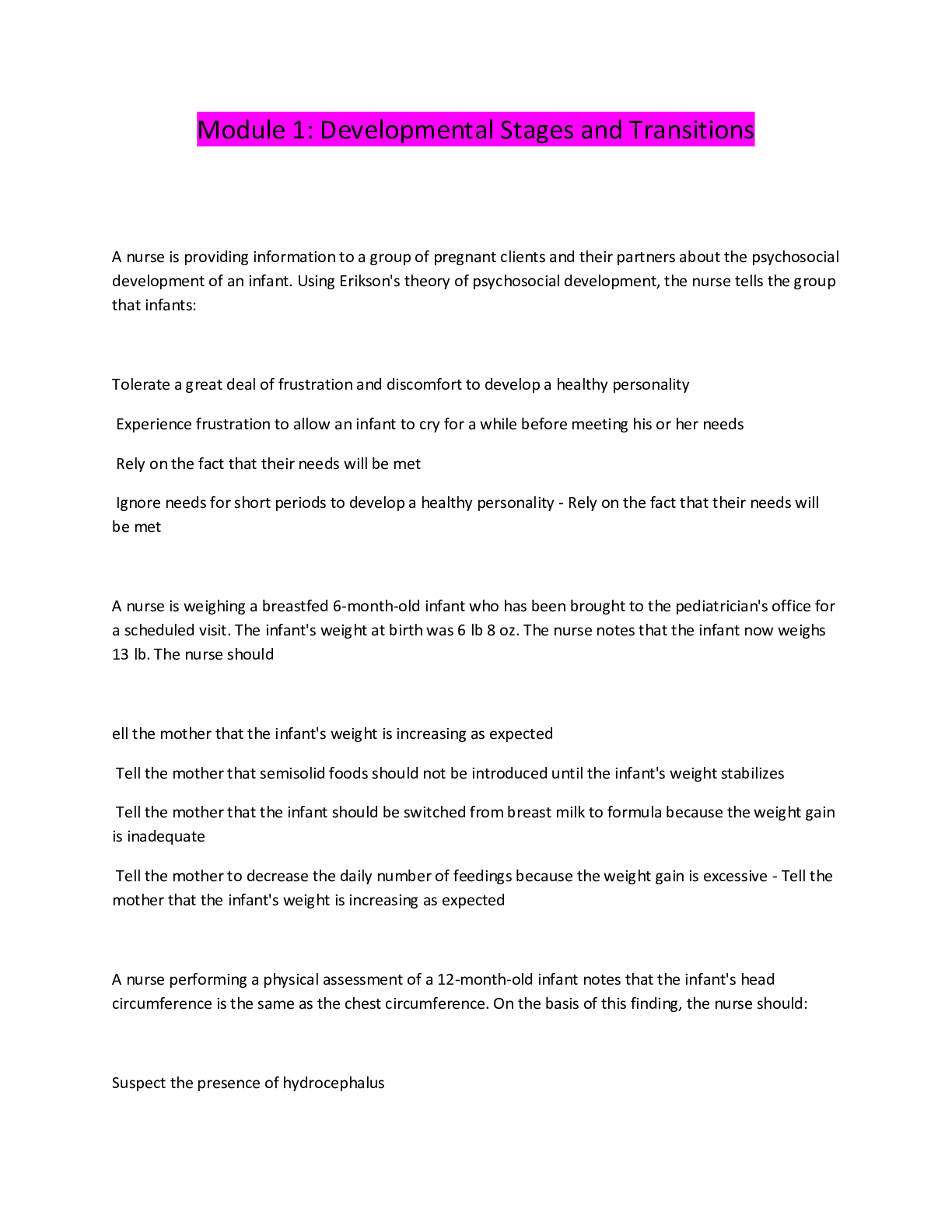
Buy this document to get the full access instantly
Instant Download Access after purchase
Buy NowInstant download
We Accept:

Also available in bundle (2)
Click Below to Access Bundle(s)
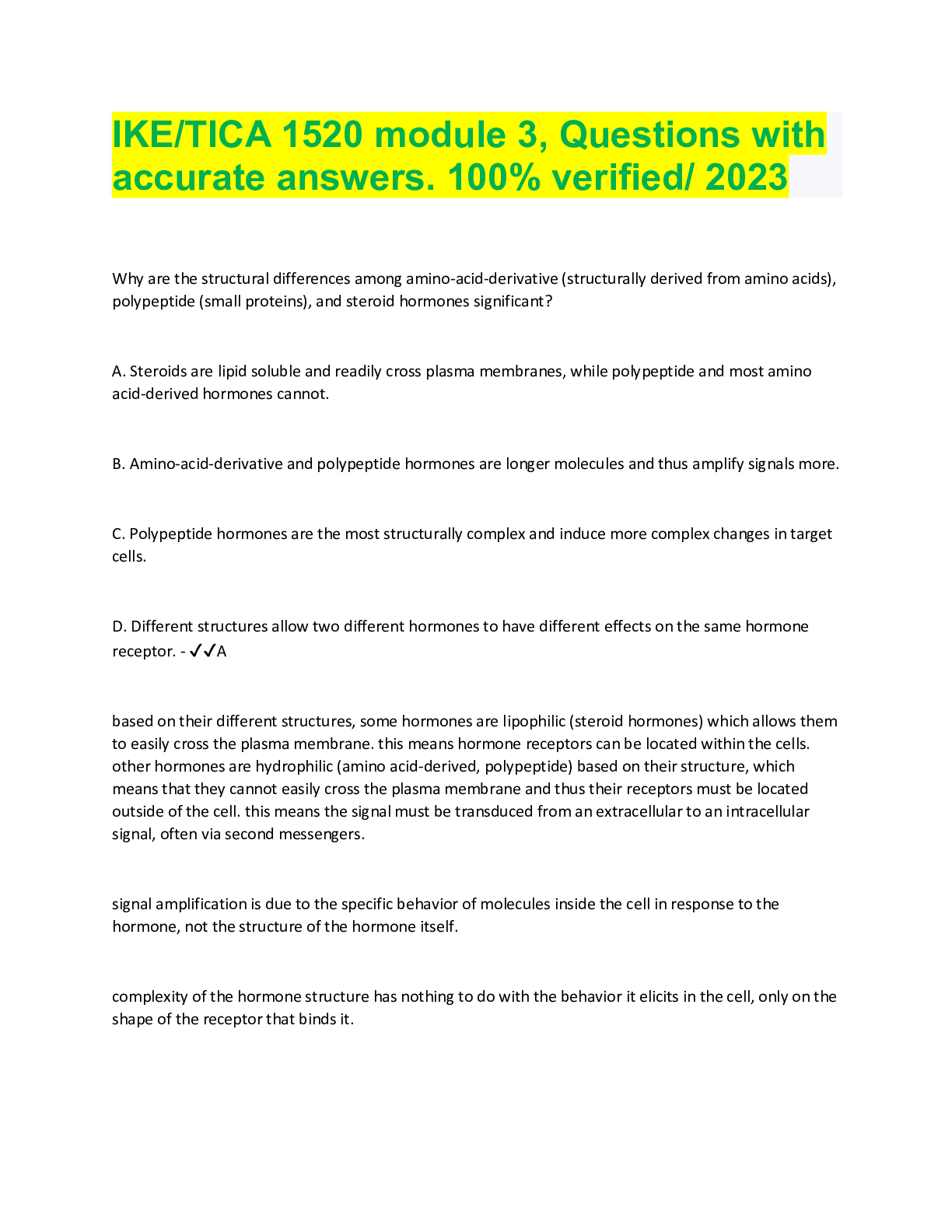
IKE/TICA BUNDLE. ALL MODULES EXAM QUESTIONS WITH ACCURATE ANSWERS, RATED A
PASS THE IKE TICA EXAMS WITH THIS BUNDLE. ALL MODULES, QUESTIONS WITH ANSWERS. GRADED A
By Topmark 3 years ago
$34
15

IKE/TICA All modules questions and answers. latest updates. rated A
All you need to pass the IKE/TICA All modules questions and answers. latest updates. rated A.
By Topmark 3 years ago
$30
14
Reviews( 0 )
$9.00
Can't find what you want? Try our AI powered Search
Document information
Connected school, study & course
About the document
Uploaded On
Oct 12, 2022
Number of pages
17
Written in
All
Additional information
This document has been written for:
Uploaded
Oct 12, 2022
Downloads
0
Views
211

